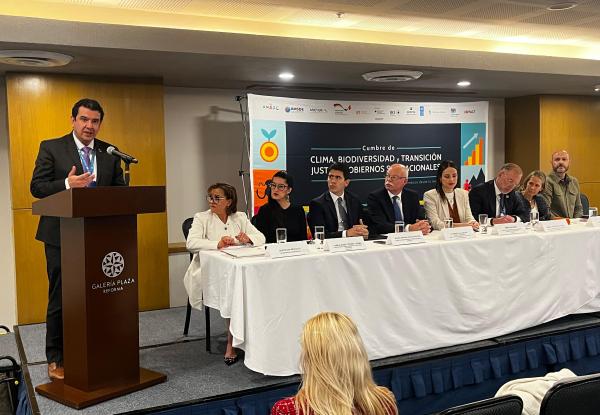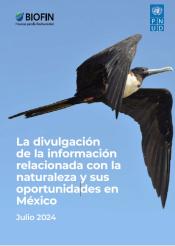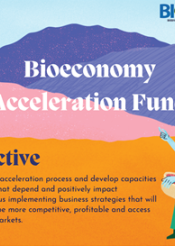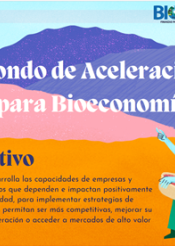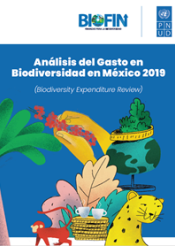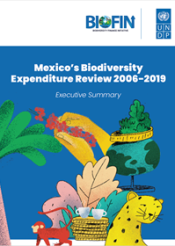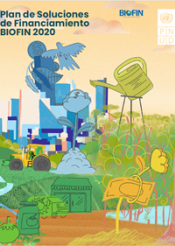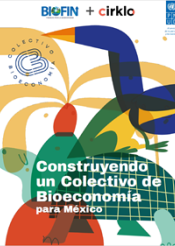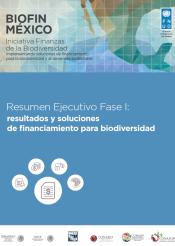Mexico
Mexico is a mega diverse country, between 10 and 12% of the world’s species can be found in its territory. Mexico is the third place globally in mammal diversity, with over 564 species (30% of them being endemic), and the second in reptiles with 864 different species (45% of them are also endemic). The country is also a biocultural hotspot being center of origin of globally widespread species and hosts a rich natural heritage safeguarded by indigenous peoples and local communities. Over 5,000 species of flora (equivalent to 23%) have a traditional use, with over 3,000 medicinal plants in the country.
The land in Mexico is mostly managed by communities and ejidos (communal land) who mainly depend on primary sector activities (specifically agriculture, extensive livestock, forestry, fisheries, and hunting) for a living. Therefore, conservation actions must consider the social governance of these biodiversity rich territories.
Mexico faces complex underlying causes of biodiversity degradation. According to the National Geography and Statistics Institute (2019), the Environmental Degradation and Resource Depletion Total Costs that have a negative impact on natural resources account to 4.5% of the GDP. Additionally, the federal biodiversity expenditure has been decreasing since 2015, with USD 732 million spent in biodiversity in 2019, being the lowest expenditure in a decade.
In this sense, BIOFIN Mexico understands that the finance gap would be unsurmountable through fiscal budget. Therefore, it is currently working to develop innovative financial solutions beyond increasing public budget, by involving other actors and sectors. The financial and private sector are increasingly looking to incorporate and consider biodiversity in their finance portfolios, either as a profitable investment or as an element to consider in their financial and non-financial potential risks. BIOFIN is seizing the opportunity to involve these sectors and to develop finance mechanisms that provide economic benefits as well as social and environmental impacts.
- Design of the Sustainable Fund, a financial instrument that will channel international, national, public, and private resources at a national level.
- Mobilizing USD 294k from irrigation districts towards Payments for Environmental Services through Matching Funds, conserving 7,300 ha.
- Helped the Protected Areas Commission to negotiate with the Ministry of Finance the return of entrance fees, leveraging USD 2m.
- Creation of the Bioeconomy Acceleration Fund with over 190 applications, financing and offering technical assistance to 10 projects, ensuring social and biodiversity impacts.
- Development of Finance Solutions Plans and implementation of biodiversity finance mechanisms at the subnational level, resulting in strengthened public funds; creation of Green Investment Offices; and the promotion of expenditure efficiency and aligning policies.
- Recommendations for the financial sector on the best principles and standards that could be implemented for regulatory improvements.
- Leverage of additional resources from international cooperation agencies, international financial institutions, CSOs and subnational governments.
29 Octubre 2025
1. Greening Financial Flows in Cross-sectoral policies
This solution entails the modification of relevant public policy instruments to include biodiversity conservation criteria into their strategic planning, rules of operation, mechanisms, and other operational instruments in the primary sector (agriculture, livestock, forestry, and fisheries). Some of the activities in this solution include reforms for public policy; reform and redirect negative subsidies; and institutionalize the Biodiversity Expenditure Review at federal and subnational level.
2. Climate Change and Biodiversity Finance
Climate change resources could be reoriented towards double-dividend solutions: climate emergency and biodiversity loss. The mechanisms included in this finance solution are the promotion of Nature-based solutions as well as blue and forest carbon markets. These mechanisms have the potential to leverage great amounts of finance from the private sector, towards forest and coastal ecosystems. This would also imply increasing economic and social benefits for landowners, as well as diversifying their incomes.
3. Strengthening biodiversity finance at the subnational level
In 2019, BIOFIN started working with Mexico City in strengthen its Environmental Public Fund, to allow it to channel finance through innovative finance mechanisms to implement biodiversity, climate change and sustainable development projects; as well as implementing the BIOFIN methodology at a subnational level including the PIR and BER, making the City the first subnational entity in the world to estimate its biodiversity expenditure. The work in Mexico City opened new channels of collaboration with other subnational entities, mainly Jalisco, in strengthening four environmental funds (environmental, forestry, entrepreneurship and agricultural), develop a financial mechanisms map, and building a Green Investment Office. In 2021, new opportunities presented with Guanajuato and
Yucatán to explore finance solutions that could be linked with other finance solutions such as bioeconomy and carbon markets.
4. Bioeconomy Strategy
Bioeconomy, in the Mexican context, refers to productive actions that use biodiversity and environmental goods as the main input for creating economic and social gains ensuring net positive impact on livelihoods, communities and ecosystem functionality under a competitive and resilience approach. BIOFIN has created an environment for these investments to thrive in the fisheries, aquaculture, agriculture, forestry and tourism sectors. The strategy has two main elements: an acceleration platform (a free and public webpage) where producers, entrepreneurs and buyers meet and match; and an acceleration fund that co-finances bioeconomy business models in different maturity stages.
5. Greening the financial sector
2020 saw an increase in the interest of the financial sector in environmental disclosure, specifically related to nature. The main outcome of this solution is to develop conditions to mobilize a greater number of capital from national, international, commercial and development banks for projects with positive impact in biodiversity. In this sense, BIOFIN is supporting the National Banking and Securities Commission (CNBV) in its quest to strengthen the regulatory environment related with climate and nature disclosures.
State of the review:
Completed.
Findings:
Biodiversity expenditure for 2015 in Mexico amounted $18.6 billion pesos which represented 0.38% of public and 0.1% of the GDP. Despite the positive historical trend, pressures to public finances due to the external and the internal reasons has led to a decrease in the government budget, particularly in the total budget of the Ministry of Environment and consequently to biodiversity public programs. Taking this into account it is key to focus on financing solutions other than the increase in the public budget such as efficiency, public expenditure alignment, and avoiding future costs due to negative impacts.
Additionally, the National Evaluation Council (CONEVAL) is an autonomous public institution in charge of measuring poverty and evaluating government social programs. Despite that CONEVAL’s evaluations include biodiversity programs they rarely consider environmental impact and only focusses on the social indicators of the programs. In this sense, some of the challenges include increasing efficiency in biodiversity expenditure; monitoring and evaluating the environmental impact of public programs; as well as the impact of constant pressures to public finances. Furthermore, it is important to strengthen national financial mechanisms to channel international cooperation in a timely, efficient and effective manner. Mexico must also continue to increase its efforts in public expenditure alignment for biodiversity through landscape management approaches through pilot projects and international cooperation.
State of the review:
PIR has been completed.
Findings:
Biodiversity public policy and institutions face several challenges in Mexico. Despite there are many institutions which have biodiversity conservation and sustainable use attributions, there is still some work to do towards a better coordination among them. Currently, there are coordination mechanisms such as CONABIO, CIMARES (National Commission for Oceans), and CIBIOGEM (National Commission for Biosecurity) however their level of consolidation should be strengthened. Effective coordination mechanisms with better institutional embedding could enable the biodiversity sector to collaborate efficiently and promote mainstreaming biodiversity policies within other sectors. The national regulatory framework needs to be carefully revised in order to harmonize the wide range of conservation and sustainable use definitions within the different laws. Additionally, national planning processes need to be pushed towards continuity since public policies and instruments are subject to changes from one year to another. Hence, changes in the incentives of public programs that affect biodiversity become difficult to trace. Finally, the mainstreaming agenda in Mexico has become a crucial opportunity for strategic sectors to internalize the costs of biodiversity loss.
State of the review:
Completed
Findings:
The estimation of finance needs for biodiversity is around USD 461.9 million per year during the period 2017-2020, which represents an increase of 46.7% to biodiversity spending, based on the one exercised during 2015. The finance needs assessment includes: 1) Protected Natural Areas financial gap calculated in 60 million per year estimated by CONANP; 2) The needs of financing to cover the Payment for Environmental Services (PES) demand estimated at USD 202.1 million by CONAFOR; 3) The National Biodiversity Strategy and the Action Plan (NBSAP- ENBIOMEX) finance needs estimated at USD 191.4 million.
Another result of the finance needs assessment was that 76% of the required resources are current expenditure and 24% are investment spending.
BIOFIN's FNA has helped to establish a path of implementation for the ENBIOMEX and has shown the required resources for its implementation up to 2020.
Scoping interviews have been conducted with government officials and environmental financial experts. Consultant’s meetings and workshops have taken place to integrate the results of previous BIOFIN’s components with the Finance Plan. Some of the elements for the Biodiversity Financial Plan include the previous analysis of the current status which consist of the main drivers of biodiversity-harmful impacts; the biodiversity financing gap and programs that encourage biodiversity’s loss; the mapping of current sources of funding for the protection of biodiversity and the financing priorities; and financial guidelines for private and development banks to integrate environmental and biodiversity considerations in their investment portfolios.
The private sector involvement is another key factor for the financial sustainability of biodiversity, therefore it is a fundamental part of the BFP. Another relevant point is the prioritization of biodiversity in the national budget planning, which is directly linked with the efficient use of public resources. In addition, the integration of public and private banks is a fundamental part for the channeling of resources.
The Plan will also focus in the strategic on key financial instruments and their enabling conditions to increase funding on biodiversity conservation. Additionally, synergies and alignments through other schemes and mechanisms are being explored in order to identify potential resources that can be eventually channeled to biodiversity conservation or sustainable use.
Moreover, BIOFIN MX is playing a significant role in facilitating a dialogue on the alignment of sources, agents and instruments to improve access to project financing. Finally, BIOFIN MX is currently working in developing concrete proposals for resource mobilization while identifying: a) Source of resources b) Mechanism for channeling resources c) Instruments d) Expected financial result e) and institutional arrangements.
The BFP recognized that there is previous national experience of many instruments and mechanisms of public, private and public-private partnerships that have managed to generate and leverage additional resources to public budgets. Taking into account these mechanisms, the biodiversity finance solutions proposed by BIOFIN Mexico are the following:
- Mainstreaming of biodiversity in productive sectors, such as agriculture, tourism, fisheries and forestry. However, this finance solution also includes the Green budget based on results aligned to Sustainable Development Goals (SDG), to improve the result based planning through modification of the design, rules of operation and indicator matrix of budgetary programmes related to biodiversity and align them to the SDG.
- Climate and biodiversity finance. This includes the strenghtening of the Climate Change Fund, as a tool to leverage resources from national, international, public and private sources. Another mechanism is to fund projects of environmental infrastructure and/or ecosystem-based adaptation issues through the Environmental Programme of the National System of Public Investment (SNIP for its spanish acronym), whose purpose is financing conservation, biodiversity, restoration and pollution remediation projects.
- Finance mechanisms for conservation, which are mainly to increase the local mechanisms for the payment of environmental services programme of the Forestry Commission, and to develop conservation local mechanisms in Protected Areas.
- Impact investment and sustainable businesses, to generate a profitable portfolio of sustainable use projects that can be multiplied and scalable, so that resources from private sector could be channeled to biodiversity.
- Greening the bank. This solution includes mechanisms such as facilitating the implementation of an Environmental and Social Risk Management System (SARAS for its spanish acronym) in the financial sector, through guidelines and clear indicators. The emission of green bonds is another mechanism to anchor a portfolio of productive projects of restoration or green infrastructure for biodiversity and ecosystems.
These groups of finance solutions are not exhaustive and can be complemented with with support solutions such as a coherent international finance vision and economic and finance evaluations.
- Mexico: Finance Solutions Poster - BIOFIN 3rd Global Conference 2018
- Estrategia de Bioeconomía de BIOFIN México
- Fondo de Aceleración para Bioeconomía infografía
- Manifiesto de bioeconomía México
- Resumen del plan de soluciones de financiamiento de México
- Mobilizing Resources at the Subnational Level in Mexico
- Movilización de recursos a nivel subnacional en México

